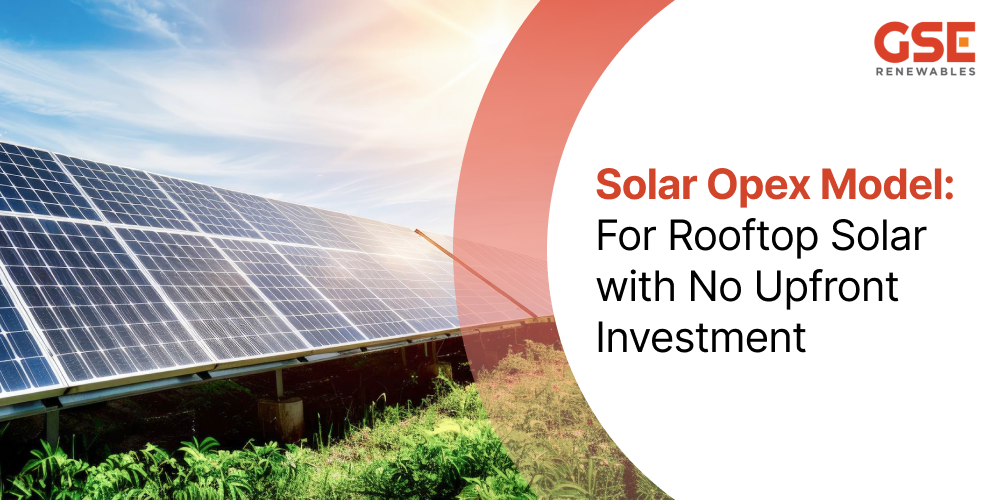500 kW Solar Power Plant Cost in Gujarat: Complete Price & Savings Guide
Nov 26

The solar OPEX model operates as a simple, no-capex payment arrangement. Customers can access solar-generated electricity without upfront investment, opting instead for a pay-as-you-go structure. Under the OPEX model in solar, operational expenses like maintenance, monitoring, and insurance are deferred and settled periodically. By entering a service agreement with a solar provider, users consume generated power and remit routine fees, avoiding steep initial costs.
The OPEX solar model streamlines solar deployment by shifting upfront capital expenses to predictable operating costs. Through a structured service agreement, businesses gain access to clean energy without bearing installation or maintenance burdens. Below is the step-by-step workflow under the OPEX model solar framework:
Adopting a solar OPEX model empowers businesses to transition to renewable energy without large capital expenditures. By shifting costs to predictable operating expenses, companies can focus on growth rather than upfront investments. The following points outline the core advantages of the OPEX model in solar:
Let’s take a look at the OPEX model, which is best suited for businesses that would like to begin utilizing solar energy. OPEX will provide huge savings in a business’s operating expenses and consumption of the power. Moving to solar will significantly lower the reliance on conventional energy sources, which will allow for lower utility bills and lower operational expenses through an OPEX solar model.
Certainly, through an OPEX model, there is often a maintenance/monitoring component from your solar contractor, which places some of the responsibility burden of keeping the system operational on the contractor. The business is not responsible for operating and maintaining the solar system itself.
Another benefit to an OPEX solar model is the tax incentives and governmental support associated with the utilization of a solar system. Many governments offer tax credits or rebates on the investment in green energy. These tax benefits are extra sources of savings, and oftentimes make continuous savings monthly.
Utilizing the OPEX solar model provides a boost to a ‘business bottom line’. Investing in a solar system does require an investment, but the savings on bills and tax incentives provide support for your company while taking advantage of renewable energy which supports the planet.
GSE Renewables Energy is an expert in industrial and commercial solar projects, offering full turnkey solutions from initial design to long-term operations and maintenance under the OPEX solar model. We focus on installing reliable solar rooftop systems that maximize ROI while providing clients a hassle-free energy management experience. By managing all operational costs, including installation, monitoring, and maintenance, we ensure businesses can transition to clean, affordable solar energy with predictable monthly expenses. Our extensive experience allows us to deliver dependable systems that combine cost efficiency, operational ease, and sustainable energy solutions for industrial and commercial clients.
The OPEX solar model serves a wide range of business sectors:
The OPEX solar model is changing how we access and use energy. These solar solutions help make solar accessible and help accelerate the deployment of renewable energy around the world. With more support from policymakers and financiers, the outlook for solar energy is looking better every day.
At GSE Renewables, we believe that clean energy should be a fundamental right and not a luxury. Our OPEX model in solar solutions is how we plan to achieve this vision by providing affordable and sustainable energy generation to rooftops everywhere. Becoming a partner is about investing in accessible energy today and a greener future for generations to come.
If you want to go solar without prohibitive upfront costs, please contact GSE Renewables today. We’ll help you transition to your cleaner and more economical solar solution according to your needs and your budget. Let’s work together to harness all of the goodness the sun has to offer, to help us make sustainable energy a reality for everybody. Please contact GSE Renewables today, and take your first step towards a sustainable future.
The solar OPEX model is an operating expense approach where a third-party owns and maintains the solar system, and the customer pays only for the electricity consumed, without upfront investment.
In CapEx, the customer buys and owns the solar system with full upfront costs, while in OPEX, the third-party owns and operates the system, and the customer only pays for the electricity generated.
No, businesses do not pay any upfront costs under the OPEX model; all installation, operation, and maintenance expenses are covered by the service provider.
The OPEX model covers installation, maintenance, operation, monitoring, insurance, and other ongoing costs related to running the solar system.
The OPEX model offers lower and more predictable electricity tariffs than the grid, and removes upfront costs and maintenance expenses, thus reducing overall energy bills.
Yes, the OPEX model is ideal for small and medium enterprises, as it eliminates high upfront investment and provides flexible, pay-as-you-use solar energy solutions.
Our Blogs With a combined experience of over 250 years and the successful management of 30 MW of solar energy projects, GSER offers the most efficient solutions. 500 kW Solar Power Plant Cost in Gujarat: Complete Price & Savings Guide What is a 500 kW...
Read MoreOur Blogs With a combined experience of over 250 years and the successful management of 30 MW of solar energy projects, GSER offers the most efficient solutions. Why Solar Power Is Booming in Gujarat for Businesses Over the last decade, Gujarat has become one of...
Read MoreOur Blogs With a combined experience of over 250 years and the successful management of 30 MW of solar energy projects, GSER offers the most efficient solutions. Solar Opex Model: For Rooftop Solar with No Upfront Investment What is the OPEX Model in Solar Energy?...
Read More